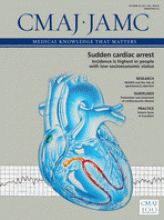Sudden cardiac arrest

Image courtesy of © 2011 Thinkstock
The incidence of sudden cardiac arrest was higher in poorer neighbourhoods than in richer neighbourhoods in seven North American cities studied, although the association was less marked in Canada than in the US. Reinier and colleagues analyzed data from a population-based registry of sudden cardiac arrests occurring outside hospital and census data linked to patients’ places of residence. The authors suggest that efforts to reduce cardiovascular risk factors and to improve survival from sudden cardiac arrest be targeted to lower-income communities to reduce disparities in incidence. See Research, page 1705
The highest incidence of premature, sudden cardiac arrest occurs in populations with low socioeconomic status. Population-based efforts to reduce cardiovascular risk factors among lower-income communities may be the most effective strategy to combat the single most common cause of death in western societies. See Commentary, page 1692
NSAIDs may not be safe in pregnancy
Taking nonaspirin nonsteroidal anti-inflammatory drugs was associated with more than doubling of the risk of spontaneous abortion. Examining routine data from a provincial pregnancy registry and drug plan, Nakhai-Pour and colleagues conducted a case–control analysis comparing 4705 women who had had a spontaneous abortion with 10 times the number of women in the control group. These drugs should be used with caution during pregnancy, say the authors. See Research, page 1713
Serious causes of syncope
The San Francisco Syncope Rule should be applied only for patients in whom no cause of syncope is evident after initial evaluation in the emergency department. Saccilotto and colleagues reviewed and summarized 12 studies in this bivariate meta-analysis and found a pooled sensitivity of 87% and pooled specificity of 52% for detecting a serious outcome. Whether the accuracy of the rule could be improved by routinely including information from cardiac monitoring may be an avenue for further research, say the authors. See Research, page E1116

Image courtesy of © 2011 Thinkstock
Educated clinical judgment based on evidence-based guidelines seems to be the best strategy for the management of patients presenting to emergency departments with syncope. See Commentary, page 1694
Prevalence of metabolic syndrome

Image courtesy of © 2011 Thinkstock
One in five Canadian adults had metabolic syndrome in 2007–2009. This prevalence measure is based on data from the cross-sectional Canadian Health Measures Survey. Public health initiatives to improve dietary habits and physical activity are needed, say the authors. See Research, page E1127
C-CHANGE Initiative

Image courtesy of © 2011 Thinkstock
With many guidelines available for risk management of cardiovascular disease, it can be difficult for physicians to determine which ones to use, which risk factors to address first and which treatment targets to follow. The C-CHANGE Initiative used a consensus model to harmonize and integrate more than 400 recommendations into a more manageable package of key recommendations. The authors stress that most patients at moderate and high risk of cardiovascular events will require a combination of modifications to health behaviours and pharmacologic interventions to meet treatment targets. See Guidelines, page E1135
Enteric fever
Vaccines licensed for the prevention of typhoid fever confer only partial protection against typhoid fever, while the oral formulation provides partial protection against one type of paratyphoid infection additionally. Beaulieu and Boggild stress that a history of immunization against typhoid does not preclude enteric fever as a diagnosis in returned travellers with fever. See Practice, page 1740
Pyoderma gangrenosum
In patients with rapidly progressive ulceration occurring after trauma, negative results on microbiological analysis should prompt consideration of pyoderma gangrenosum as a diagnosis. See Practice, page 1746








